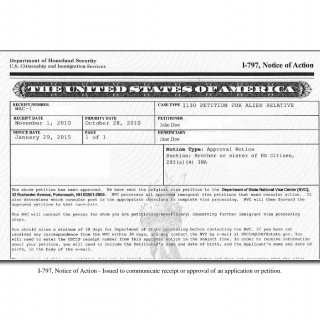Form I-797. Notice of Action
Form I-797 is a Notice of Action issued by U.S. Citizenship and Immigration Services (USCIS) to inform applicants or petitioners about the status of their application or petition. The appearance of the form can vary depending on the type of notice being issued.
However, in general, a Form I-797 usually contains information such as the receipt number, the date of receipt, and the type of form that was filed. The top of the form typically includes the USCIS logo and the title "Notice of Action." The rest of the form includes administrative information about the case, such as the applicant's name, address, and immigration status.
If the Form I-797 is an approval notice, it may also include information about when the applicant can expect to receive their new immigration document, such as a green card or work permit. Overall, the appearance of the Form I-797 will depend on the particular notice being issued by USCIS.
What Is Form I-797 Used For?
Form I-797, also known as a Notice of Action, is used by U.S. Citizenship and Immigration Services (USCIS) to notify applicants or petitioners about the status of their immigration case. The form contains important information about the application or petition, including whether it has been approved, rejected, or is still being processed.
Here are some specific uses of Form I-797:
1. Receipt Notice: When an applicant or petitioner files an immigration application with USCIS, they will receive a Form I-797 as a receipt notice. This notice confirms that USCIS has received the application, provides a case number, and estimates the processing time for the application.
2. Approval Notice: If an immigration application is approved, USCIS will issue a Form I-797 as an approval notice. This notice confirms that the applicant's request has been granted and includes details about the next steps in the process.
3. Request for Evidence (RFE): If USCIS needs additional information to process an application or petition, they may issue a Form I-797 as an RFE notice. This notice requests specific documentation or information from the applicant or petitioner, and provides a deadline for submission.
4. Denial Notice: If an immigration application is denied, USCIS will issue a Form I-797 as a denial notice. This notice explains the reasons for the denial and provides information on how to appeal the decision.
Overall, Form I-797 is an important document in the immigration process, and it is critical that applicants and petitioners keep track of any notices they receive from USCIS.
How to Get Form I-797?
Form I-797 is typically issued by U.S. Citizenship and Immigration Services (USCIS) and is sent by mail to the applicant or petitioner's address listed on their application or petition. Here are the general steps for obtaining Form I-797:
-
Submit an Application or Petition: To receive Form I-797, you must first submit an immigration-related application or petition to USCIS.
-
Wait for Receipt Notice: After USCIS receives your application or petition, they will issue a Form I-797 as a receipt notice. This notice confirms that USCIS has received your application and provides a case number and estimated processing time.
-
Watch for Other Notices: Depending on the status of your application or petition, USCIS may issue additional Form I-797 notices, such as an approval notice, request for evidence notice, or denial notice.
-
Contact USCIS: If you have not received a Form I-797 notice within a reasonable amount of time after submitting your application or petition, you can contact USCIS to inquire about the status of your case.
Overall, the process for obtaining Form I-797 depends on the specific type of notice being issued by USCIS. It is important to keep track of any notices you receive from USCIS and to follow up with them if you have any questions or concerns about your immigration case.
Differences Between Form I-797 and Form I-797C Notices of Action
There are several types of Form I-797 notices issued by U.S. Citizenship and Immigration Services (USCIS), including Form I-797 and Form I-797C. While both forms serve a similar purpose of notifying applicants or petitioners about the status of their case, there are some differences between them.
Form I-797 is a Notice of Action that USCIS issues to provide information on the status of an application or petition. This form can be used for several purposes, such as:
-
Receipt Notice: USCIS sends out a Form I-797 as a receipt notice to confirm that they have received your application or petition.
-
Approval Notice: If USCIS approves your application or petition, they will issue a Form I-797 as an approval notice, which provides information on what to do next.
-
Request for Evidence (RFE) Notice: If USCIS needs more information to process your application or petition, they may send you a Form I-797 as an RFE notice, which requests specific documentation or information from you.
On the other hand, Form I-797C is also a Notice of Action, but it is specifically used to communicate certain types of information, such as:
-
Biometric Appointment Notice: USCIS sends out a Form I-797C to notify applicants of their biometrics appointment, which is required for background checks.
-
Interview Appointment Notice: USCIS sends out a Form I-797C to notify applicants of their interview appointment, which is typically required for employment-based or family-based immigration applications.
Overall, while both Form I-797 and Form I-797C are Notices of Action used to provide information on the status of an application or petition, they differ in terms of the specific type of information being communicated.

